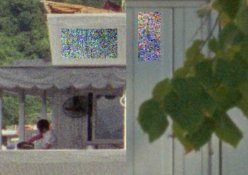I've fun with your efforts to demonstrate that some people around, users of several scanners (Dainippon 8060 drum scanner, Dainippon 1045, CREO IQSMART3, Imacon 848, SCREEN CEZANNE), still didn't understand that a "high-end flatbed scan" is better than a 8060 drum scan. Probably they have a masochistic attitude to keep working a 500kg drum scanner to get a worse image quality.
I think that your technical considerations are on a completely wrong road...
1. I told you yet before that to compare different scanners you should scan the same negatives and you should know the settings adopted for each scan.
2. You avoided to specify extremely important things about your scan: type of film, model of scanner, type of mounting, settings applied in this scan (camera, lens, etc apart).
3. "it's a nice way to compare scan resolutions: you apply autolevels to iniform part of the image and immediately see how sharp is your scanner": that's an amateur unacceptable and weird simplification, and you can't use your method of showing the rendition of the grain to determine the resolution of a scanning system:
3.1 - DRY mounting produces always crisper but worse and unpleasant grain
3.2 - CCD scanners allow just to set the resolution, A/D parameters of conversion etc...They don't allow to set the apertures to change the relationship between sampling frequency (spi) and optical resolution (setted by the use of several different apertures, up to 25 in some scanners)
3.3 - The main goal of a high-end scan is to achieve the best compromise between detail and noise reduction: that's what has been done in the scan posted at the beginning of this POST. The 8060 drum scanenr has several different apertures. The smallest aperture allows of course the highest detail (about 11.000 true optical dpi) but a more unpleasant grain, similar to your noisy scan but much more detailed. Here Instead, to get the best results a medium aperture has been adopted: it allowed to extract all the details recorded by the lens and to reduce noise and grain at the minimum level.
Theese are the principles of a true high-end scan that you can print up to the largest sizes mantaining all the original details recorded by the lens on the film.
btw: also, state-of-the-art PMT (drum) scanners are able to extract a much wider color gamut and wider dynamic range from both slides, bw and color negatives than CCD scanners: that's the reason of a huge visible difference of quality in the actual final output (prints, etc).
Concluding, that's why CastorScan adopts just their 8060 pmt-drum scanner for their high-end scans instead of their CREO IQSMART3, Imacon 848 or Screen Cezanne CCD scanners (or others...).






